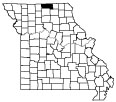Missouri Courthouses
Contact and other information about this county is available on the National Association of Counties website.
Editor’s note
The PDF version of this publication includes illustrations. Select the “Download this publication” button.
 County: Putnam
County: Putnam
Organized: Feb. 28, 1845
Named after: Gen. Israel Putnam of Bunker Hill
County seat: Unionville
Putnam County, organized in 1845, apparently has had six different courthouses. While the first county seat and first courthouse were in Putnamville, county officials moved the county seat several times before permanently establishing it a Unionville.
Little information exists about the first three courthouses in the county. The court record does show that an order from the court on June 16, 1845, called for the county's first courthouse to be built on a corner lot in Putnamville. At that time, county jurisdiction included land extending nine miles north into Iowa.
Joseph Guffey built the Putnamville courthouse for $169.25; it was ready for occupancy in September 1845. Robert Cochran superintended Guffey's work.
Next, the county seat moved to either Calhoun or Winchester. A court order called for a move to Calhoun in August 1847, according to Goodspeed's 1888 History. However, the order may never have been fulfilled. If the county seat was established at Calhoun, it would have been only for a short time, since in August 1848 the court received a petition asking for relocation of the county seat from Putnamville to a location in the center of the county, which the court named Winchester. In February 1849 the order came to sell the old courthouse in Putnamville, indicating that a new courthouse must have been ready in either Calhoun or Winchester. Ross Asbell bought the Putnamville structure.
The record described a rather unusual procedure for building the courthouse in Winchester, which presumably was built on the 160-foot public square with William J. Cook as superintendent:
. . . the letting of the court house be divided into three classes; First - Pulling down, moving and raising the pillars three on each side; second - putting on roof, undertaking to furnish everything, gable ends included; third - flooring, sleepers, joist and two doors. . . .
On July 10, 1854, the court ordered the Winchester courthouse sold for not less than $150.
In June 1851 an election called for removal of the seat to Fairplay, later called Hartford. The town was to be laid out on the same plan as Winchester. Nothing is known of this courthouse except that it was ordered sold in 1855. Participants in the Old Settlers Reunion in 1903 noted it had disappeared.
Dodge County, which no longer exists, organized in 1846 and was located west of Putnam County. It too extended north to include land in present-day Iowa. When the Missouri-Iowa boundary dispute was settled in 1851, neither Putnam nor Dodge contained the minimum territory required by state law for county organization. Therefore, in 1853 Dodge County became attached to Putnam. The county seat was relocated in 1854 to the new geographical center of the county and symbolically named Harmony. But, in 1855 the name was changed to Unionville.
David Thatcher superintended construction of the temporary courthouse built in Unionville in about 1853-54 west of the public square. The two-story, log building, 18 by 24 feet, had a brick chimney, stone foundation, and four 12-light windows. The cost was $250. The court used this building from 1854 to 1858.
Construction on the next courthouse, a two-story, red brick structure, built on the square, began in May 1857 and ended during December 1858. Smith A. John was superintendent of the building, which cost $11,175 (Figure 1). Apparently, the courtroom on the second floor was condemned and was not used in the 1880s. The court ordered the building sold Jan. 7, 1890. A local organization, called Soldier's Reunion, bought it for $250 with the understanding it was to be removed by May 1890. The court kept the bell, weathervane and safes.
Putnam County then was without a courthouse for more than 30 years. In February 1923 citizens presented a petition calling for an election to authorize construction of a courthouse. Few counties, it was pointed out, did not have a courthouse. An election in June 1923 authorized expenditure of $150,000 for construction. So elated were residents of Unionville, they celebrated in the streets when election results were announced.
Figure 1
Putnam County Courthouse, 1857-1890. (From: An Illustrated Historical Atlas of Putnam County, Missouri, 1877)
Plans by J. G. Braecklein, Kansas City, were approved in August 1923 for a 62-by-92-foot, three-story building with Carthage stone facing (Figure 2). Entries were planned for each of the four sides. After receiving bids, the court awarded the $128,000 contract to George Gassman Construction Company in September 1923. Cornerstone ceremonies celebrated the progress of construction Feb. 26, 1924. The building, still in use as Putnam County's courthouse, was completed in September with its formal dedication on Nov. 11, 1924. An unsatisfactory settlement with the contractors delayed acceptance of the building until January 1925 after Gassman made concessions of $1,621 because of defective floor construction.
Figure 2
Putnam County Courthouse, 1923-. Architect: J. G. Braecklein (From: postcard, Trenton Boyd collection)
Bibliography
Books
- Davis, George. Brief History and Biography of Putnam County. 1937.
- History of Adair, Sullivan, Putnam and Schuyler Counties, Missouri. Chicago: Goodspeed Publishing Co., 1888.
- Souvenir History: Unionville Centennial, 1855-1955.
Articles and Essays
- The Putnam Journal, Old Settlers Edition, 1903.
- Thomas, John L. "Some Historic Lines in Missouri, "Missouri Historical Review" 3 (July 1909): 251-275.
Newspapers
- Putnam County Journal, Feb. 9-Sept. 21, 1923; Feb. 22-Oct. 17, 1924; Jan. 9, 1925.
- Unionville Republican, March 5, 1924; June 13, 1973, Section 2.
Maps, atlases, gazetteers
- An Illustrated Historical Atlas of Putnam County, Missouri. Philadelphia: Edwards Brothers, 1877.
- Plat Book of Putnam County, Missouri. Philadelphia: Missouri Publishing Company, 1897.